Chapter: Advanced Computer Architecture : Memory And I/O
Virtual memory & techniques for fast address translation
Virtual memory & techniques
for fast address translation
Virtual
memory divides physical memory into blocks (called page or segment) and
allocates them to different processes. With virtual memory, the CPU produces
virtual addresses that are translated by a combination of HW and SW to physical
addresses, which accesses main memory. The process is called memory mapping or
address translation.Today, the two memory-hierarchy levels controlled by
virtual memory are DRAMs and magnetic disks
Virtual
Memory manages the two levels of the memory hierarchy represented by main
memory and secondary storage. Figure 5.31 shows the mapping of virtual memory
to physical memory for a program with four pages.
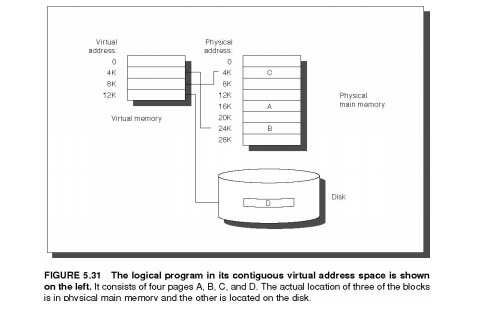
There are
further differences between caches and virtual memory beyond those quantitative
ones mentioned in Figure 5.32
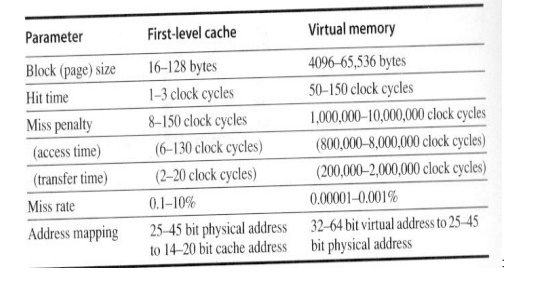
Virtual
memory also encompasses several related techniques. Virtual memory systems can
be categorized into two classes: those with fixed-size blocks, called pages,
and those with variable-size locks, called segments. Pages are typically fixed
at 4096 to 65,536 bytes, while16 segment size varies. The largest segment
supported on any processor ranges from 2 bytes
up to 32
2 bytes;
the smallest segment is 1 byte. Figure 5.33 shows how the two approaches might
divide code and data.
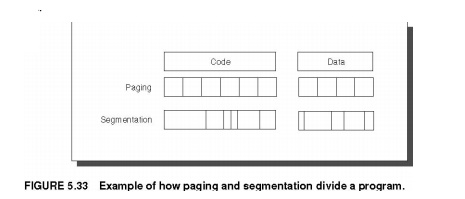
The block
can be placed anywhere in main memory. Both paging and segmentation rely
on a data
structure that is indexed by the page or segment number. This data structure
contains the physical address of the block. For segmentation, the offset is
added to the segment’s physical address to obtain the final physical address.
For paging, the offset is simply concatenated to this physical page address
(see Figure 5.35).
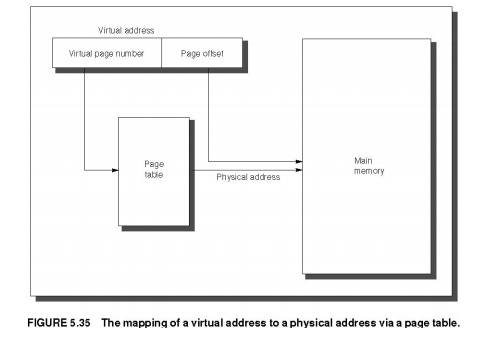
This data
structure, containing the physical page addresses, usually takes the form of a
page table. Indexed by the virtual page number, the size of the table is the
number of pages in the virtual address space. Given a 32-bit virtual address,
4-KB pages, and 4 bytes per page table entry, the size of the page table would be
To reduce
address translation time, computers use a cache dedicated to these addres
translations, called a translation look-aside buffer, or simply translation
buffer. They are described in more detail shortly.
With the
help of Operating System and LRU algorithm pages can be replaced whenever page
fault occurs.
1. Techniques for Fast Address
Translation
Page
tables are usually so large that they are stored in main memory, and some-times
paged themselves. Paging means that every memory access logically takes at
least twice as long, with one memory access to obtain the physical address and
a second access to get the data. This cost is far too dear.
One
remedy is to remember the last translation, so that the mapping process is
skipped if the current address refers to the same page as the last one. A more
general solution is to again rely on the principle of locality; if the accesses
have locality, then the address translations for the accesses must also have
locality. By keeping these address translations in a special cache, a memory
access rarely re-quires a second access to translate the data. This special
address translation cache is referred to as a translation look-aside buffer or
TLB, also called a translation buffer or TB.
A TLB
entry is like a cache entry where the tag holds portions of the virtual address
and the data portion holds a physical page frame number, protection field,
valid bit, and usually a use bit and dirty bit. To change the physical page
frame number or protection of an entry in the page
table,
the operating system must make sure the old entry is not in the TLB; otherwise,
the system won’t be-have properly. Note that this dirty bit means the
corresponding page is dirty, not that
the
address translation in the TLB is dirty nor that a particular block in the data
cache is dirty. The operating system resets these bits by changing the value in
the page table and then invalidating the corresponding TLB entry. When the
entry is reloaded from the page table, the TLB gets an accurate copy of the
bits.
Figure
5.5 shows the Alpha 21264 data TLB organization, with each step of a
translation labeled. The TLB uses fully associative placement; thus, the
translation begins (steps 1 and 2) by sending the virtual address to all tags.
Of course, the tag must be marked valid to allow a match. At the same time, the
type of memory access is checked for a violation (also in step 2) against
protection infor-mation in the TLB.
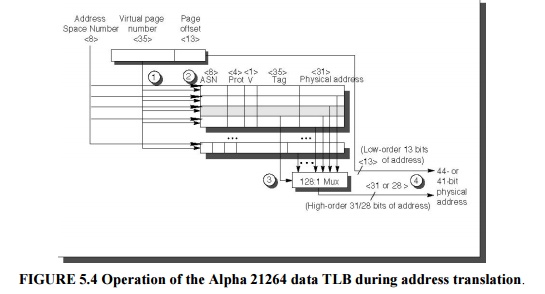
Selecting a Page Size
The most
obvious architectural parameter is the page size. Choosing the page is a question
of balancing forces that favor a larger page size versus those favoring a
smaller size. The following favor a larger size:
Ø The size
of the page table is inversely proportional to the page size; memory (or other
resources used for the memory map) can therefore be saved by making the pages
bigger.
Ø A larger
page size can allow larger caches with fast cache hit times.
Ø Transferring
larger pages to or from secondary storage, possibly over a network, is more
efficient than transferring smaller pages.
Ø The
number of TLB entries are restricted, so a larger page size means that more
memory can be mapped efficiently, thereby reducing the number of TLB misses.
Virtual memory protection
Multiprogramming
forces to worry about usage of virtual memory. So Protection is required for
virtual memory concept. The responsibility for maintaining correct process
behavior is shared by designers of the computer and the operating system. The
computer designer must
ensure
that the CPU portion of the process state can be saved and restored. The
operating system designer must guarantee that processes do not interfere with
each others’ computations.
The
safest way to protect the state of one process from another would be to copy
the current information to disk. However, a process switch would then take
seconds—far too long for a time-sharing environment. This problem is solved by
operating systems partitioning main memory so that several different processes
have their state in memory at the same time.
Protecting Processes
The simplest protection mechanism is a pair of registers that checks every ad-dress to be sure that it falls between the two limits, traditionally called base and bound. An address is valid if Base ≤ Address ≤ Bound
In some
systems, the address is considered an unsigned number that is always added to
the base, so the limit test is just (Base + Address) ≤ Bound
If user
processes are allowed to change the base and bounds registers, then users can’t
be protected from each other. The operating system, however, must be able to
change the registers so that it can switch processes. Hence, the computer
designer has three more responsibilities in helping the operating system
designer protect processes from each other:
Ø Provide
at least two modes, indicating whether the running process is a user process or
an operating system process. This latter process is sometimes called a kernel
process, a supervisor process, or an executive process.
Ø Provide a
portion of the CPU state that a user process can use but not write. This state
includes the base/bound registers, a user/supervisor mode bit(s), and the exception
enable/disable bit. Users are prevented from writing this state because the
operating system cannot control user processes if users can change the address
range checks, give themselves supervisor privileges, or disable exceptions.
Ø Provide
mechanisms whereby the CPU can go from user mode to supervisor mode and vice
versa. The first direction is typically accomplished by a system call,
implemented as a special instruction that transfers control to a dedicated
location in supervisor code space. The PC is saved from the point of the
sys-tem call, and the CPU is placed in supervisor mode. The return to user mode
is like a subroutine return that restores the previous user/supervisor mode.
2. A Paged Virtual Memory
Example: The Alpha Memory Management and the 21264
TLB
The Alpha
architecture uses a combination of segmentation and paging, providing
protection while minimizing page table size. With 48-bit virtual addresses, the
64-bit address space is first divided into three segments: seg0 (bits 63 - 47 =
0...00), kseg (bits 63 - 46 = 0...10), and seg1 (bits 63 to 46 = 1...11). kseg
is re-served for the operating system kernel, has uniform protection for the
whole space, and does not use memory management.
User
processes use seg0, which is mapped into pages with individual protection.
Figure 5.38 shows the layout of seg0 and seg1. seg 0 grows from address 0
upward, while seg1 grows downward to 0. This approach provides many advantages:
segmentation divides the address space and conserves page table space, while paging
provides virtual memory, relocation, and protection.
The Alpha
uses a three-level hierarchical page table to map the address space to keep the
size
reasonable. Figure 5.5 shows address translation in the Alpha. The addresses
for each of these page tables come from three “level” fields, labeled level1,
level2, and level3. Address
translation
starts with adding the level1 address field to the page table base register and
then reading memory from this location to get the base of the second-level page
table.
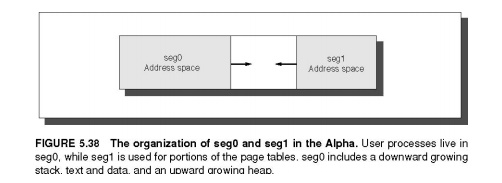
The
level2 address field is in turn added to this newly fetched address, and memory
is accessed again to determine the base of the third page table. The level3
address field is added to this base address, and memory is read using this sum
to (finally) get the physical address of the page being referenced. This
address is concatenated with the page offset to get the full physical address.
Each page table in the Alpha architecture is constrained to fit within a single
page.
The first
three levels (0, 1, and 2) use physical addresses that need no further
translation, but Level 3 is mapped virtually. These normally hit the TLB, but
if not, the table is accessed a second time with physical addresses.
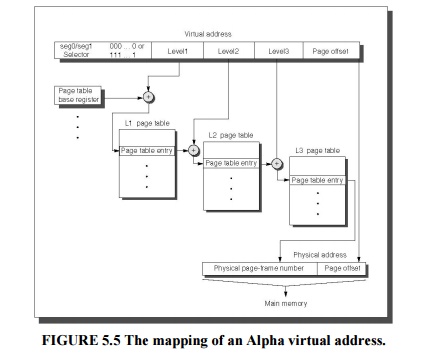
The Alpha
uses a 64-bit page table entry (PTE) in each of these page tables. The first 32
bits contain the physical page frame number, and the other half includes the
following five protection fields:
Valid—Says
that the page frame number is valid for hardware translation User read
enable—Allows user programs to read data within this page Kernel read
enable—Allows the kernel to read data within this page User write enable—Allows
user programs to write data within this page
Kernel
write enable—Allows the kernel to write data within this page
In
addition, the PTE has fields reserved for systems software to use as it
pleases. Since the Alpha goes through three levels of tables on a TLB miss,
there are three potential places to check protection restrictions. The Alpha
obeys only the bottom-level PTE, checking the others only to be sure the valid
bit is set.
3. A Segmented Virtual Memory
Example: Protection in the Intel Pentium
The
original 8086 used segments for addressing, yet it provided nothing for virtual
memory or for protection. Segments had base registers but no bound registers
and no access checks, and before a segment register could be loaded the
corresponding segment had to be in physical memory.
Intel’s
dedication to virtual memory and protection is evident in the successors to the
8086 (today called IA-32), with a few fields extended to support larger
addresses. This protection scheme is elaborate, with many details carefully
designed to try to avoid security loopholes.
The first
enhancement is to double the traditional two-level protection model: the
Pentium has four levels of protection. The innermost level (0) corresponds to
Alpha kernel mode and the outermost level (3) corresponds to Alpha user mode.
The IA-32 has separate stacks for each level to avoid security breaches between
the levels.
The IA-32
divides the address space, al-lowing both the operating system and the user
access to the full space. The IA-32 user can call an operating system routine
in this space and
even pass
parameters to it while retaining full protection. This safe call is not a
trivial action, since the stack for the operating system is different from the
user’s stack. Moreover, the IA-32
allows
the operating system to maintain the protection level of the called routine for
the parameters that are passed to it. This potential loophole in protection is
prevented by not allowing the user process to ask the operating system to
access something indirectly that it would not have been able to access itself.
(Such security loopholes are called Trojan horses.)
Adding Bounds Checking and Memory Mapping
The first
step in enhancing the Intel processor was getting the segmented addressing to
check bounds as well as supply a base. Rather than a base address, as in the
8086, segment registers in the IA-32 contain an index to a virtual memory data
structure called a descriptor table. Descriptor tables play the role of page
tables in the Alpha. On the IA-32 the equivalent of a page table entry is a
segment descriptor.
It
contains fields found in PTEs:
A present
bit—equivalent to the PTE valid bit, used to indicate this is a valid
translation A base field—equivalent to a page frame address, containing the
physical address of the
first
byte of the segment
An access
bit—like the reference bit or use bit in some architectures that is helpful for
replacement algorithms
An
attributes field—specifies the valid operations and protection levels for
operations that use this segment
There is
also a limit field, not found in paged systems, which establishes the upper
bound of valid offsets for this segment. Figure 5.41 shows examples of IA-32
segment descriptors.
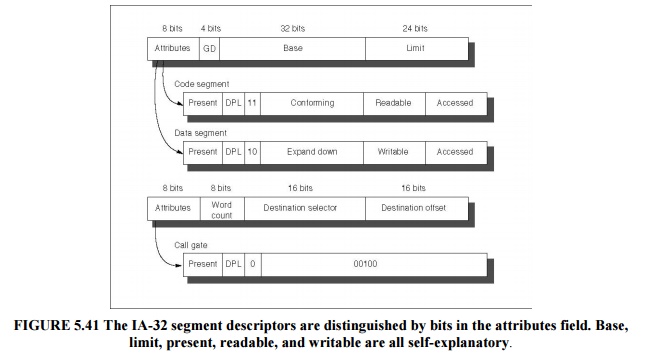
IA-32
provides an optional paging system in addition to this segmented addressing.
The upper portion of the 32-bit address selects the segment descriptor and the
middle portion is an index into the page table selected by the descriptor.
Adding Sharing and Protection
To
provide for protected sharing, half of the address space is shared by all
processes and half is unique to each process, called global address space and
local address space, respectively. Each half is given a descriptor table with
the appropriate name. A descriptor pointing to a shared segment is placed in
the global descriptor table, while a descriptor for a private segment is placed
in the local descriptor table.
Related Topics